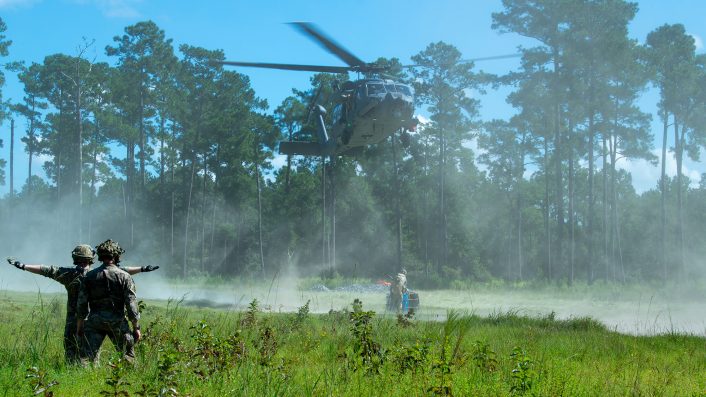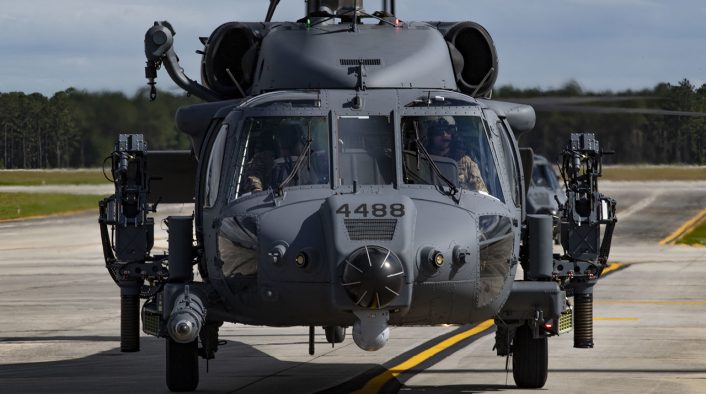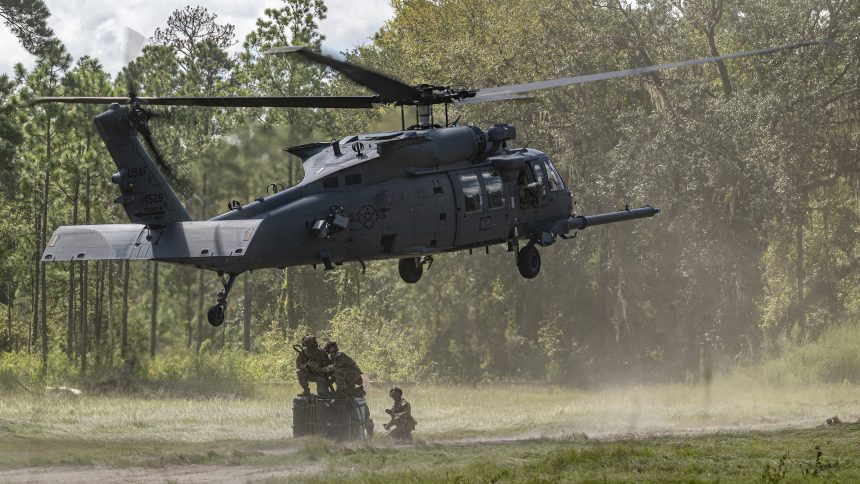Moody AFB leverages HH-60W Jolly Green II’s sling load capabilities for Agile Combat Employment.
On Aug. 29, 2024, the 347th Operations Support Squadron at Moody Air Force Base in Georgia conducted sling load training with the HH-60W Jolly Green II helicopter. The training, which involved the 41st Rescue Squadron, 820th Base Defense Group, and 824th Base Defense Squadron, focused on relocating cargo between austere locations using the maneuverability of the HH-60W; a key element of the Agile Combat Employment (ACE) concept.
The ACE concept aims to increase the flexibility and resilience of U.S. Air Force operations by enabling rapid repositioning of forces across different environments. Utilizing the HH-60W Jolly Green II for cargo transport showcases how Air Force personnel adapt to the challenges posed by austere environments. The helicopter’s ability to access areas that other aircraft might struggle to reach, due to size or mobility constraints, provides commanders with additional options to sustain forces at main operating bases, forward operating sites, and contingency locations.
Training for Expanded Capabilities
“This training is important because we need to increase the capabilities of the HH-60W, and their pilots and crews need to become qualified,” said TSgt. Benjamin Griggs, 347th OSS aerial delivery noncommissioned officer in charge, in an official press release. “We’re able to train here in a safe environment, so that they will be able to perform a sling load, if needed, down range.”
The HH-60W’s sling load training program is relatively new to the Air Force and combat search and rescue missions. Through these exercises, the Air Force is working to develop and establish a standardized sling load program to ensure that aircrews can demonstrate operational competence and readiness in real-world scenarios. As the Air Force continues to evolve its combat search and rescue approach, regular training sessions are planned to maintain high standards and proficiency in sling load operations.

Expanding the Role of Multi Capable Airmen
Moody AFB’s sling load training also integrates the expertise of 2T2 transportation specialists, expanding their roles to include sling load operations in challenging environments. In the U.S. Air Force, a 2T2 is an Air Transportation Specialist responsible for managing cargo and passengers on military aircraft, including loading, unloading, and ensuring the safe and efficient movement of personnel and supplies. They handle everything from planning and scheduling air transport to operating specialized equipment like forklifts and loaders. Their duties also include inspecting and securing cargo, ensuring compliance with safety regulations, and maintaining detailed records of transportation operations.
The training certifies these specialists in rigging and directing sling load operations, enhancing their capabilities as Multi Capable Airmen (MCA). This concept aligns with the broader goal of making the Air Force’s ACE strategy more resilient to adversary attempts to disrupt U.S. freedom of action.
“A variety of vertical lift platforms across the joint force possess sling load capabilities,” stated Griggs. “Certifying 2T2s in rigging and directing sling-load operations was a natural way to test the Multi Capable Airman capability and make the Air Force’s Agile Combat Employment concept more resilient to adversary attempts to deny our freedom of action.”
The training underscores the importance of integrating various Air Force specialties into a cohesive force capable of executing a wide range of tasks in support of combat operations. By expanding the skill sets of personnel like the 2T2 transportation specialists, the Air Force aims to enhance its overall operational flexibility and readiness.
A Focus on Innovation and Future Preparedness
As the Air Force continues to refine its approach to CAS operations, the Airmen at Moody AFB plan to conduct quarterly sling load training sessions to ensure they are well-prepared for future challenges. This commitment to regular, rigorous training reflects the Air Force’s focus on maintaining high standards of performance and readiness in all mission areas.
“The 2T2’s execution of the operation was a major accomplishment, but their drive to innovate is the more important outcome,” Griggs noted. “It’s what we need each community to continue doing to give us a competitive advantage and control the domains we affect.”
The emphasis on innovation and adaptability is crucial as the Air Force navigates an increasingly complex global security environment. By continually exploring new ways to leverage existing platforms and capabilities, the Air Force ensures that it remains at the forefront of operational readiness and effectiveness.
The sling load training with the HH-60W Jolly Green II at Moody AFB exemplifies the Air Force’s commitment to expanding its operational capabilities and enhancing its ability to respond to diverse mission requirements. By integrating sling load operations into combat search and rescue missions and developing the skills of Multi Capable Airmen, the Air Force is not only improving its logistical agility but also setting a new standard for innovation and operational excellence in the modern battlefield.
HH-60W
The HH-60W Jolly Green II is the newest U.S. Air Force combat rescue helicopter which is replacing the HH-60G Pave Hawk as the primary Combat Rescue Helicopter. The Jolly Green II is tasked with recovering isolated personnel from hostile or restricted areas under a wide range of conditions, including adverse weather and various threat environments, such as terrorist and CBRN situations. It also supports humanitarian missions, civil search and rescue, disaster relief, medevac, and non-combatant evacuations.
Built specifically for Combat Search and Rescue (CSAR), the HH-60W features advanced mission systems that enhance situational awareness for aircrews in contested environments. The aircraft is equipped with updated multi-function displays, advanced defensive systems, and integrated communications to increase survivability and effectiveness.
Upgrades include a digital radar warning receiver, laser and missile warning systems, chaff and flare dispensers, armor for the cabin and cockpit, external 7.62 mm and .50 caliber weapons, LINK 16 data link, situational awareness enhancements, upturned IR-masking exhausts, and advanced rotor blades for improved performance.










